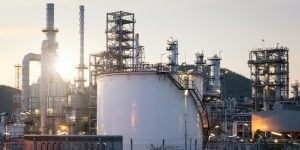Currently, natural gas production in the United States is rising due to extraction techniques known as hydraulic fracturing and horizontal drilling. These techniques, in part, have made the U.S. one of the largest exporters of liquid natural gas (LNG) and met the increasing global demand.
Technological advancements in the carbon capture and storage (CCS) market also reduce the effects of natural gas production and usage. The best natural gas stocks explore both avenues for potential earnings growth.
So, with that said, here are three of the best natural gas stocks for investors to consider.
Chesapeake Energy (CHK)

Despite current market challenges, I’m bullish on Chesapeake Energy (NASDAQ:CHK). The market has been unimpressed with CHK’s performance, as it recently reached a 52-week low. My optimism remains despite its Q2 2024 net loss of $227 million.
This decline, though disappointing, is more a result of the unfavorable natural gas environment than problems within the company. Chesapeake’s cost management is commendable; it has narrowed the capital and production expense guidance for 2024 by 4% and 8%, respectively.
CHK is positioned to successfully navigate its predicted upswing because commodities trade cyclically in and out of favor. Wall Street also appears to agree with my sentiment. EPS is predicted to surge 303.42% to $5.51, while its top-line could strengthen top 10.05B or a 158.46% increase from 2024’s forecasted levels.
Even if CHK doesn’t reach these stratospheric levels, there’s a reasonable chance it could appreciate substantially in the immediate future, making it one of the best natural gas stocks to buy.
Antero Resources (AR)

Like the other best natural gas stocks to buy in this article, Antero Resources (NYSE:AR) has also faced some short-term challenges that I believe it will eventually overcome. Last quarter, AR achieved record-breaking well lengths, averaging over 18,000 lateral feet per well, a 16% increase from their previous record. This means that AR stock can extract more natural gas from each well they drill.
AR stock also claims to be one of the most efficient players in the natural gas industry, with maintenance capital 43% below the average of its peers.
While AR has a high amount of leverage, with $4.38 billion of debt on its balance sheet, it has reduced $2 billion of that total since 2019. All of these factors indicate that AR could be on the right track in terms of management focus and cost-saving measures, with rising organic demand for natural gas being its significant catalysts.
Range Resources (RRC)

As this article shows, I’m bullish on Range Resources (NYSE:RRC) despite the prevailing market situation.
A great positive is that Range’s hedging strategy has been sound; it has realized that natural gas prices have been higher than the NYMEX prices. Their NGL realizations are also very good, realizing premiums over the Mont Belvieu equivalent prices.
The company’s financial condition is also stable, as it has sufficient cash and diligently pays off its debts. The announcement of the $1.1 billion share repurchase program also depicts that Range has faith in its future growth prospects.
I chose RRC as one of the best natural gas stocks for investors who prefer less speculative options in the market. As evidenced by its generation of $274.48 million of free cash flow in the last twelve months and its market capitalization of $6.95 billion, one may have a higher chance of preserving capital by investing in RRC than in more speculative options.
On the date of publication, Matthew Farley did not have (either directly or indirectly) any positions in the securities mentioned in this article. The opinions expressed are those of the writer, subject to the InvestorPlace.com Publishing Guidelines.
On the date of publication, the responsible editor did not have (either directly or indirectly) any positions in the securities mentioned in this article.
Matthew started writing coverage of the financial markets during the crypto boom of 2017 and was also a team member of several fintech startups. He then started writing about Australian and U.S. equities for various publications. His work has appeared in MarketBeat, FXStreet, Cryptoslate, Seeking Alpha, and the New Scientist magazine, among others.
